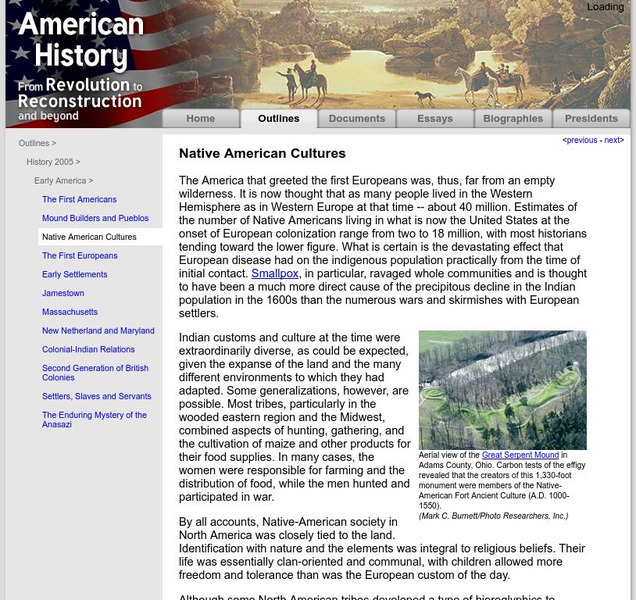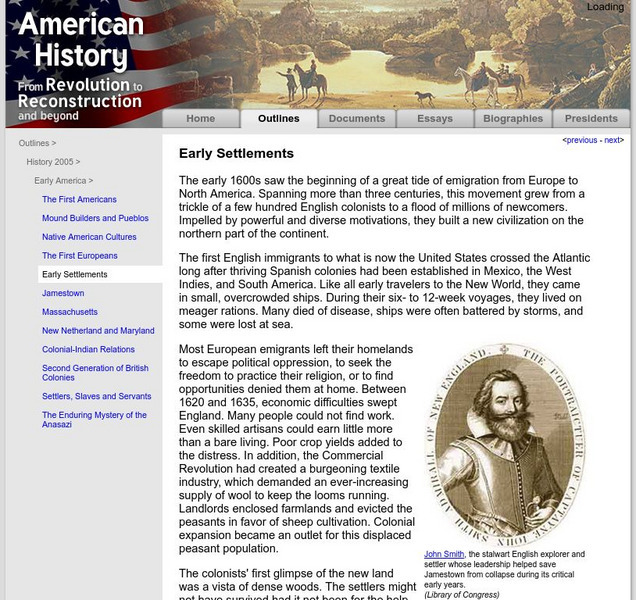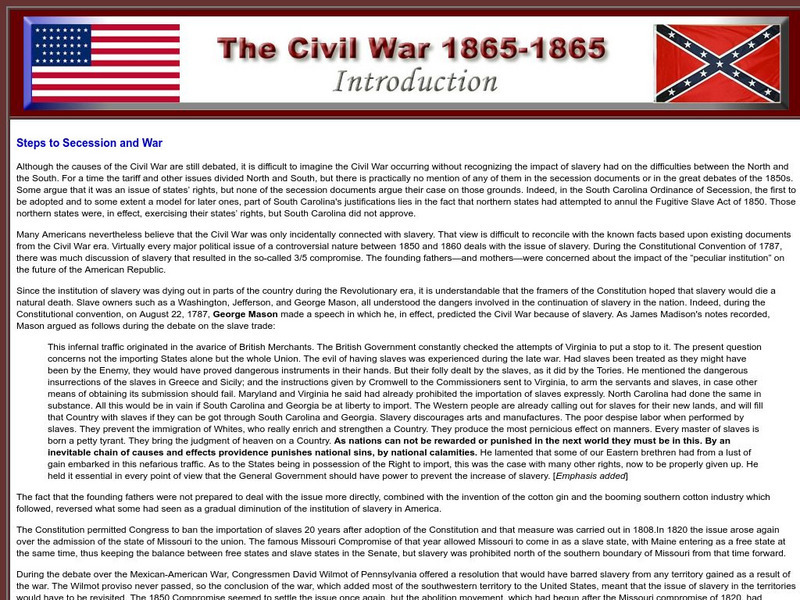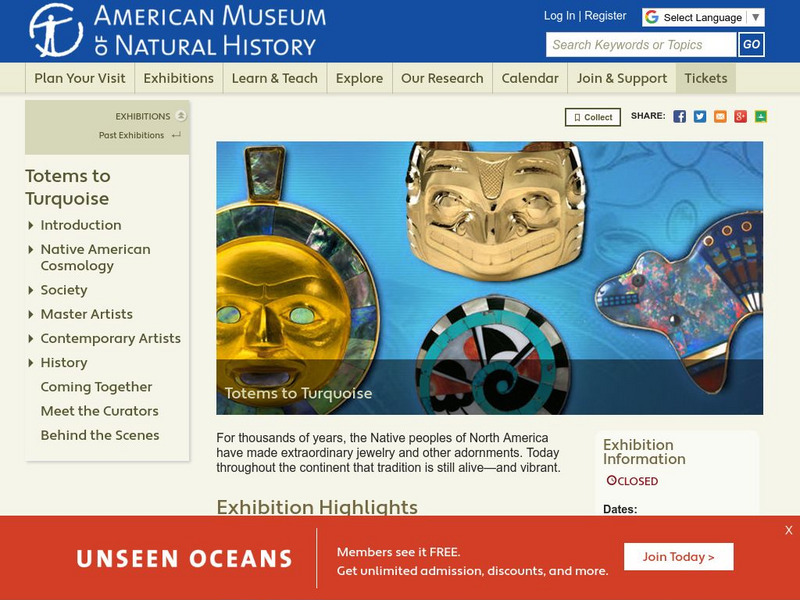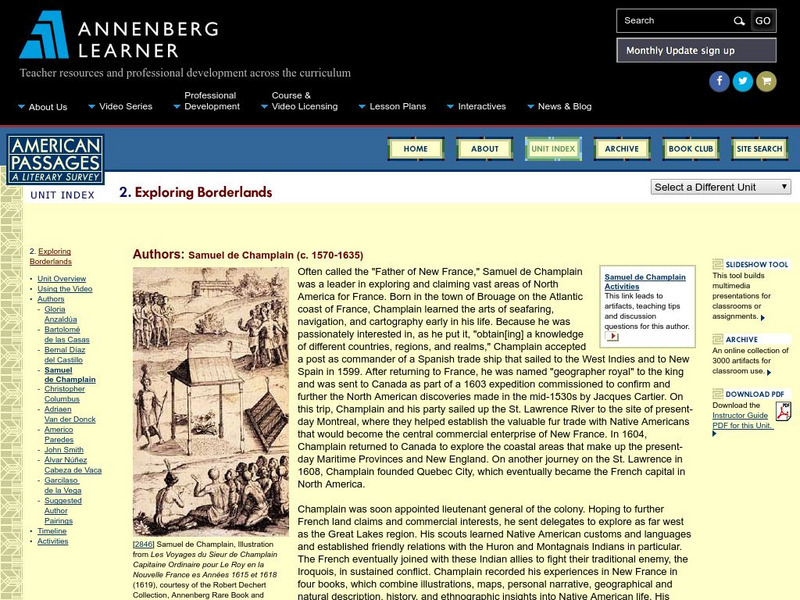Duke University
Conscience of a Nation: John Hope Franklin on African American History
An exhibition on African-American history that is inspired by the work of John Hope Franklin (1915-2009), an African-American scholar who studied the historical roots of racial prejudice. The exhibit presents primary documents, texts,...
University of Groningen
American History: Outlines: Native American Cultures
The America that greeted the first Europeans was, thus, far from an empty wilderness. It is now thought that as many people lived in the Western Hemisphere as in Western Europe at that time -- about 40 million. Estimates of the number of...
CommonLit
Common Lit: Text Sets: Native American History
This is a collection of 27 Grade-Leveled texts (4-12) on the topic Native American History. Before European settlers came to North America, millions of native people lived in many unique societies. Explore the history of Native Americans...
Smithsonian Institution
National Museum of Natural History: North American Mammals
The National Museum of Natural History provides users the opportunity to create personalized field guides of North American mammals based on a wide variety of search options.
Other
University of Exeter: Money in North American History
This resource provides information about money in North America from Wampum to electronic transfer.
Stephen Byrne
History for Kids: North American History
History reference page for elementary students provides an overview of early American history from the age of Columbus through the Civil War and abolition of slavery. Includes links to teacher resources.
University of Groningen
American History: Outlines: Early Settlements
The early 1600s saw the beginning of a great tide of emigration from Europe to North America. Spanning more than three centuries, this movement grew from a trickle of a few hundred English colonists to a flood of millions of newcomers....
University of Groningen
American History: Outlines: The Enduring Mystery of the Anasazi
Time-worn pueblos and dramatic cliff towns, set amid the stark, rugged mesas and canyons of Colorado and New Mexico, mark the settlements of some of the earliest inhabitants of North America, the Anasazi (a Navajo word meaning "ancient...
University of Groningen
American History: Outlines: The First Europeans
The first Europeans to arrive in North America -- at least the first for whom there is solid evidence -- were Norse, traveling west from Greenland, where Erik the Red had founded a settlement around the year 985. In 1001 his son Leif is...
University of Groningen
American History: Outlines: Jamestown
The first of the British colonies to take hold in North America was Jamestown. On the basis of a charter which King James I granted to the Virginia (or London) company, a group of about 100 men set out for the Chesapeake Bay in 1607....
University of Groningen
American History: Outlines: New Netherland and Maryland
Hired by the Dutch East India Company, Henry Hudson in 1609 explored the area around what is now New York City and the river that bears his name, to a point probably north of present-day Albany, New York. Subsequent Dutch voyages laid...
Library of Congress
Loc: Primary Documents in American History: Treaty of Ghent
This web page from the U.S. Library of Congress includes a brief bibliographic record and a link to a digital copy of the original. The Treaty of Ghent was negotiated in Belgium and it ended hostilities between the United States and...
University of Groningen
American History: Outlines: Panama and Nafta
Brief description of Panama and North American Free Trade Agreement (NAFTA) negotiated by President George Bush and ratified during the Clinton administration.
Henry J. Sage
Sage American History: American Economic Growth 1820 1860
Article outlines the boom in early American economic growth as a result of Northern industry in manufacturing, steam power, transportation and the role of government between 1820 and 1860.
Henry J. Sage
Sage American History: Civil War Introduction
Article introducing the Civil War. The author provides background information on the debates between the North and South eventually leading to war.
Henry J. Sage
Sage American History: Colonial Life: Faith, Family, Work
Article illustrating colonial life in North America. The author discusses religion and religious movements, women and the colonial family, and work, including slavery, during the 17th and 18th Century. Photographs and links to primary...
Northwestern University
Northwestern University: Edward S. Curtis's the North American Indian
The Library of Congress presents over 2,000 prints from the work of the famed photographer,Edward S. Curtis, who recorded Native American dress, ceremonies, life, and culture representing over 80 tribes during the first half of the 20th...
Smithsonian Institution
National Museum of Natural History: American Mammals: Hog Nosed Skunk
The Smithsonian Museum of Natural History, in a section titled "North American Mammals," offers a general overview of the North American hog-nosed skunk. Additional content includes detailed drawings, photographs, and a map showing the...
Smithsonian Institution
National Museum of Natural History: Arctic Science: Dna and the Peopling of Siberia
Scientists from the University of Arizona are conducting Y chromosome research on native Siberians to try to determine whether there is a genetic affinity to North American native people. The rationale and direction of this research are...
Smithsonian Institution
National Museum of Natural History: The Hall of Arctic People
This is the online version of the Smithsonian Institute's exhibit devoted to the people of the Siberian and North American Arctic. The mannequins around the walls represent the peoples of the Crossroads region, dressed in traditional...
American Museum of Natural History
American Museum of Natural History: Totems to Turquoise: Native American Jewelry
Through this resource, the user can learn about the hand-crafted jewelry of Native North Americans of the Northwest and Southwest and how it embodies both the personal and collective identity of the maker and the wearer.
Other
The Museum of the Southeast American Indian
The University of North Carolina museum's site offers articles, videos, artwork, crafts, music, and histories of Native Americans.
Annenberg Foundation
Annenberg Learner: American Passages: Exploring Borderlands: Samuel De Champlain
This passage highlights passionate French explorer, Samuel de Champlain, in his conquest for new lands in present day Canada and his establishment of France's North American capital of Quebec. Click the "Samuel de Champlain Activities"...
University of Groningen
American History: Biographies: Lord North (1713 1792)
Lord North was Prime Minister of Great Britain from January, 1770 to March, 1782. His early successes as Leader of the House and his efforts to cut the national debt brought him the confidence of a faction-ridden Parliament and the favor...

